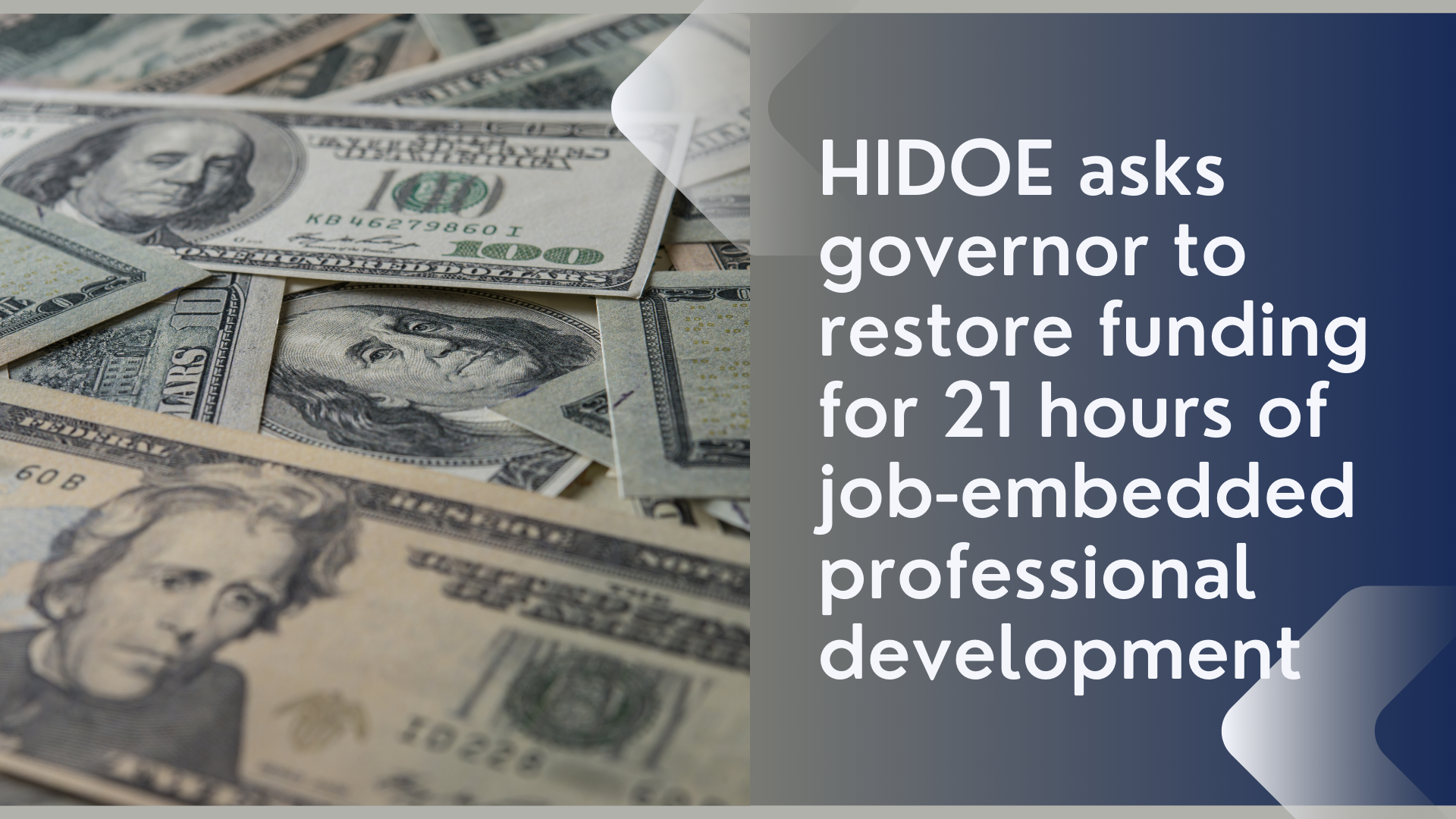The department does not plan to use federal pandemic relief funds which could restore PD funds faster
Posted: December 16, 2021
At a Board of Education meeting Thursday called to hear the Hawaii Department of Education (HIDOE)’s plan to use federal funds in the second and third rounds of the Educational Stabilization Elementary and Secondary School Emergency Relief (ESSER) funds, education department officials said they do not plan to use federal funds to restore 21 hours of job-embedded professional development (PD) for Hawaii educators.
Instead, interim Superintendent Keith Hayashi said that “we have already transmitted a request to Governor Ige to fully fund and reinstate the 21 hours for teachers. So that request has gone in to the governor.”
That development came on the same day U.S. Education Secretary Miguel Cardona urged school systems to use federal pandemic relief funds to boost public school teachers’ base pay to help recruit and retain them, something HIDOE is not planning to do with the monies.
BOE Finance and Infrastructure Committee Chair Bruce Voss indicated that the 21 hours are expected to be in Ige’s supplemental budget request, meaning the Hawaii Legislature will decide whether to fund the 21 hours. If the request is approved by lawmakers and signed into law, the soonest the funds could be available would be next school year.
However, federal ESSER funds could be used to fund the reinstatement of 21 hours for this school year, meaning teachers could get their job-embedded professional development back sooner. Yet, the HIDOE is choosing to pursue its reinstatement via the legislative route.
State Budget Director Craig Hirai testified to the BOE that state tax revenues are up and the state’s Council on Revenues has revised its forecast upwards. At the conclusion of bargaining the current HSTA collective bargaining agreement that began July 1, 2021, the following was agreed to by both HSTA and the HIDOE: “Should alternate and appropriate funding become available to the department, the parties shall endeavor to reinstate for the 21-hours.”
HSTA President Osa Tui, Jr. stated in his testimony to the board, “ESSER funds satisfy the ‘alternate and appropriate funding’ clause, and we will await the department to endeavor to reinstate the 21 hours as was agreed.”
The need to restore 21 hours
In written testimony to the BOE, teachers across the state expressed the need to restore 21 hours of job-embedded professional development which began with the 2013-14 school year and ended abruptly this year.
Caroline Freudig, Kalāheo Elementary teacher and HSTA Kauai Chapter President said, “By restoring the 21 hours of job-embedded PD, the Board of Education will be supporting teachers and their students by providing dedicated time for teachers to work on their practice in order to reach all learners.”
“Restoring the paid 21 hours could also restore our teachers’ social emotional well-being which, in turn, would support their students’ social-emotional well-being,” Freudig stated.
Hanalei Elementary teacher Angie Fisher Berad, said, “I feel like I’m struggling this year because I am given absolutely no time to plan and collaborate with my colleagues. Our faculty meetings are packed with other agendas and we are having to do a lot of extra work on our own time. If the 21 hours were reinstated, it would have such a positive impact for all teachers across the state because we need this valuable time to work and collaborate with our colleagues.”
Janelle Chong, a middle school mathematics teacher at Honouliuli Middle said, “It’s no secret that teaching is an exhausting profession, and this component of the previous HSTA contract provided one of the most viable way for public school teachers like myself to be recognized and compensated for on-the-job training that advances our professional practice.”
BOE criticizes HIDOE’s plan on reporting, accountability for funds
Hayashi presented the HIDOE’s plan for the ESSER funds, which include addressing learning loss and student social and emotional well-being. He maintained that the department is developing “clear strategies” to stabilize education with alignment and consistency. Every quarter, data on program effectiveness will be reviewed for accuracy and posted on the HIDOE website dashboard for review, Hayashi said.
However, the BOE expressed skepticism at the plan’s specificity and data collection to analyze its effectiveness, citing a lack of clear plans for implementing the federal funds and virtually no way of analyzing the plan’s effectiveness.
Several board members commented that the HIDOE’s presentation to the board did not give enough specificity about what kinds of programs would be offered at the schools and accountability is important because the state’s use of federal funds can be audited.
Hayashi went on to promise prompt updates to the board with program details to be presented more thoroughly at the BOE meeting in March when the board will look at program results and reassess their fiscal responsibilities.
Calling for transparency and accountability, BOE member Christine “Kili” Namauʻu, said to Hayashi, “You have a tremendous amount of opportunity to make a difference. You have the monies now to really make the difference…I’m just asking you to figure out some kinds of goals, some kinds of targets that can show us the board that this money is making a difference on our students. Please focus back on the students.”
Maui High arts and communication teacher Lisa Morrison testified that ESSER HIDOE’s plan “fails to provide for additional support for students on core coursework, including mathematics; it fails to suggest funding more personnel to provide assistance to teachers, fill vacancies, and expand student and staff mental support; and it doesn’t invest more in the digital learning system for students enrolled at in-person school.”
“I remain disappointed that the plan lacks specificity, even after feedback pleading for clearer direction. The plan appears to push responsibility for planning down to the complex level without giving guidance on what schools are supposed to opt to do and how much programs cost,” said Morrison, who also serves as secretary-treasurer for the Hawaii State Teachers Association.

